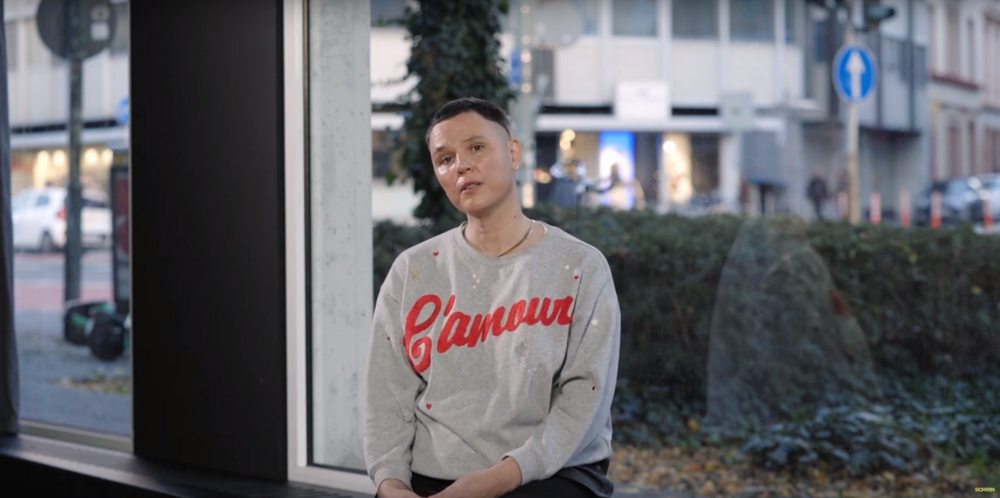Ominous, dark premonitions define the mood of Blaise Kirschner’s video work “Unica” (2022). Or is it much more repressed memories of the past? Oscillating between virtuality and reality, in our upcoming Double Feature we accompany protagonist Unica B while she shoots a postapocalyptic video game
Unica B (Grete Gehrke) is swiftly clad in a completely black suit that is equipped with so-called trackers, and then she is immediately completely alone in a large, spartan room. Off-screen we hear a digitally distorted voice: “On the desk, photographs of a catastrophe. Maps that can be folded or rolled out […] In the drawer: a car key.” We are on the set for the shooting of a postapocalyptic video game. Unica B’s body is scanned using a motion capture method, her movements measured by the trackers attached to her, and the data inputted into a digital doll. The voice off-screen gives poignant instructions as to where the actress should move to and what she should do once there. What she should do is something typically called ‘looting’ in video games: So here she bags a lighter, there a lamp, in the next room a sword with which she can later fight enemies.


In her lunch break Unica B phones her mother, Unica A (Gabrielle Scharnitzky), who is completely worked up. The walls of her studio are completely covered in drawings – “Patterns, organs, tubes, intestines, assess, climbing plants, hands with testicles,” as she tells her daughter – and she is being persecuted by a disconcerting, but beautiful dream, that likewise has to do with organs and snakes.
Elements of future or past catastrophes
Sinister, ominous premonitions define the mood in Blaise Kirschner’s video work “Unica” (2022). Or is it much more repressed memories of the past?
This becomes ever more unclear in the course of the action, the individual strands of which increasingly interweave as the video progresses. Kirschner, whose artistic oeuvre includes films and multi-media installations, created the piece at the invitation of Fluentum, a platform for collecting, presenting, and producing contemporary art that focuses on time-based media. This year, it premiered there as part of the “In Medias Res: Media, (Still) Moving” program. Fluentum’s exhibition spaces in Berlin’s Dahlem district were built in 1936-38 as the HQ of the Gau Air Force Command III, meaning at exactly the time when Hitler’s preeminent architect Albert Speer was drawing up the plans to transform Berlin into the Reich capital Germania. There is an echo of that catastrophic megalomania in Kirschner’s work when Unica B in the further course of the piece moves to the Teufelsberg to start looting there, too. However, this time her booty are fragments of ruins and rusty metal, as Berlin’s Teufelsberg hill is not a natural rock formation, but arose from the rubble gradually moved to the site from the end of the War till 1972 and collected from buildings in the city ruined in the bombing raids.

Such associations and cross-references crop up repeatedly in “Unica.” The title itself refers to German author and artist Unica Zürn, on whose illustrations and literary oeuvre Blaise Kirschner draws in her piece – in particular Zürn’s texts and images for the manuscript of “Das Haus der Krankheiten,” produced in 1958. In the latter, Zürn highlights her own body analogously to a house in which the organs, eyes and heart form the rooms that can be entered and of which it is no longer utterly clear whether they belong to the person in question or not. In “Unica,” Blaise Kirschner links elements of future or past catastrophes, of individual or intersubjective perception, the overlap of virtuality and reality as well as thoughts on corporality and matter to create a complex, ominous narrative.
Game engines to reenact traumas
The counterpart film that Blaise Kirschner has chosen is “Ariadne” (2019), made by US artist Jacky Connolly – her video works are so-called machinimas. The neologism is made up of the words for machine and cinema and refers to films shot by means of a computer game. Here, the artist makes use of the game engines from the well-known life simulator “Sims 3,” which she herself enjoyed playing as a teenager. However, unlike in her youth she does not use the game to flee into dreamworlds: Connolly utilizes the game engine in her own films to reenact trauma. In “Ariadne” she mixes scenes she herself shot of New York by night, in which a young woman (played by Connolly herself) is met by a bald man, with scenes she created using “Sims 3.”

Jacky Connolly, Ariadne, 2019, Film Still, © Jacky Connolly, Image via jackyconnolly.com

Jacky Connolly, Ariadne, 2019, Film still, © Jacky Connolly, Image via jackyconnolly.com
The somber reality on the one hand contrasts with the Italian country residence on a balmy summer evening on the other. However, the two worlds seem to be linked together by a storm, giving rise to further, digital realities. We viewers do not really know whether we are watching the ominous premonition of a disaster or are in the middle of the sinister aftershocks of a past catastrophe. Avoiding any dialog, in “Ariadne” Jacky Connolly relies on the language of the images and music to provide a narrative on working through traumas and in which (as in Kirschner’s “Unica,” too) different levels of time and realities blend and together open up spaces that seem to be connected to the inner states of the figures.
This is perhaps similar to the drawings on which the camera in “Unica” repeatedly focuses: in twisting and curving lines that unite with the limbs to create something new, the total entirety of which forever eludes our grasp.










